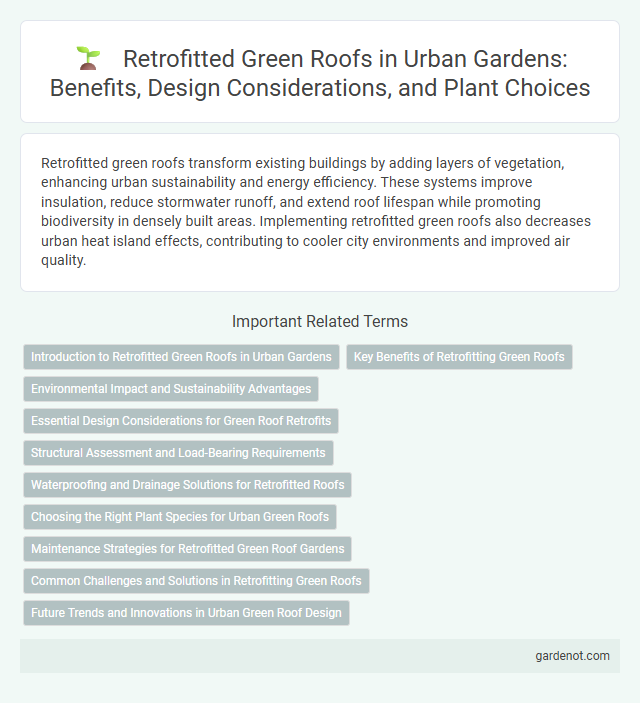Retrofitted green roofs transform existing buildings by adding layers of vegetation, enhancing urban sustainability and energy efficiency. These systems improve insulation, reduce stormwater runoff, and extend roof lifespan while promoting biodiversity in densely built areas. Implementing retrofitted green roofs also decreases urban heat island effects, contributing to cooler city environments and improved air quality.
Introduction to Retrofitted Green Roofs in Urban Gardens
Retrofitted green roofs transform existing urban structures by adding vegetative layers that enhance biodiversity, reduce heat islands, and improve stormwater management. These systems involve installing waterproof membranes, root barriers, and lightweight soil substrates on pre-existing rooftops to support plant growth without compromising structural integrity. Urban gardens benefit from retrofitted green roofs by creating sustainable green spaces that contribute to air quality improvement and energy savings in dense city environments.
Key Benefits of Retrofitting Green Roofs
Retrofitting green roofs enhances urban sustainability by improving stormwater management, reducing heat island effects, and increasing building energy efficiency. These green roofs contribute to improved air quality and provide additional insulation, lowering heating and cooling costs. Retrofitted green roofs also extend roof lifespan by protecting roofing materials from ultraviolet radiation and temperature fluctuations.
Environmental Impact and Sustainability Advantages
Retrofitted green roofs significantly reduce urban heat island effects by enhancing insulation and promoting evapotranspiration, which lowers ambient temperatures. They improve stormwater management by absorbing rainfall, reducing runoff, and decreasing the burden on municipal drainage systems. These sustainable installations contribute to air quality improvement by filtering pollutants and support biodiversity by providing habitats for urban wildlife.
Essential Design Considerations for Green Roof Retrofits
Retrofitted green roofs require careful assessment of existing roof structure load capacity, waterproofing integrity, and drainage systems to ensure long-term performance and prevent damage. Selecting appropriate lightweight growing media and drought-resistant vegetation optimizes structural safety while enhancing thermal insulation and stormwater management. Integrating proper root barriers and irrigation design is crucial to maintain plant health and protect underlying roofing materials during retrofit installation.
Structural Assessment and Load-Bearing Requirements
Retrofitted green roofs demand precise structural assessment to evaluate the existing building's load-bearing capacity, ensuring it can support the additional weight of soil, vegetation, and water retention systems. Engineers conduct thorough analyses of roof slabs, beams, and columns to confirm compliance with safety margins and building codes. Adequate reinforcement or load redistribution may be necessary to prevent structural failure and optimize long-term performance.
Waterproofing and Drainage Solutions for Retrofitted Roofs
Retrofitted green roofs require advanced waterproofing membranes specifically designed to prevent leaks and protect existing roof structures from water infiltration. Effective drainage solutions such as layered drainage mats and filter fabrics ensure proper water flow, preventing water pooling and structural damage. Integrating these waterproofing and drainage systems enhances the durability and performance of retrofitted green roofs, promoting sustainability and building resilience.
Choosing the Right Plant Species for Urban Green Roofs
Selecting the right plant species for retrofitted urban green roofs is crucial for maximizing environmental benefits such as stormwater management and thermal regulation. Native drought-tolerant succulents, sedums, and grasses are ideal choices due to their low maintenance requirements and ability to thrive in shallow substrates. Incorporating biodiversity with a mix of perennials and ground covers enhances resilience against pests and extreme weather, promoting long-term sustainability and ecosystem support.
Maintenance Strategies for Retrofitted Green Roof Gardens
Retrofitted green roof gardens require tailored maintenance strategies focusing on irrigation management, vegetation monitoring, and structural integrity assessments to ensure long-term performance. Employing automated irrigation systems and drought-tolerant plant species reduces water stress while routine inspections detect drainage issues and substrate compaction early. Integrating these maintenance practices enhances sustainability and maximizes the ecological benefits of retrofitted green roofs.
Common Challenges and Solutions in Retrofitting Green Roofs
Retrofitting green roofs often faces challenges such as structural load limitations, waterproofing integrity, and drainage system compatibility. Solutions include conducting thorough structural assessments, applying advanced root-resistant waterproof membranes, and designing efficient drainage layers to prevent water pooling. Integrating lightweight growing media and modular green roof systems can also address weight concerns while ensuring optimal plant health.
Future Trends and Innovations in Urban Green Roof Design
Retrofitted green roofs are evolving with advancements in lightweight substrate technologies and integrated water recycling systems to enhance urban sustainability. Innovations such as smart irrigation sensors and modular vegetation panels are optimizing plant health and maintenance efficiency in densely built environments. Future trends emphasize multifunctional green roofs that combine energy generation, biodiversity habitats, and climate resilience to address urban challenges comprehensively.
Retrofitted green roof Infographic

 gardenot.com
gardenot.com